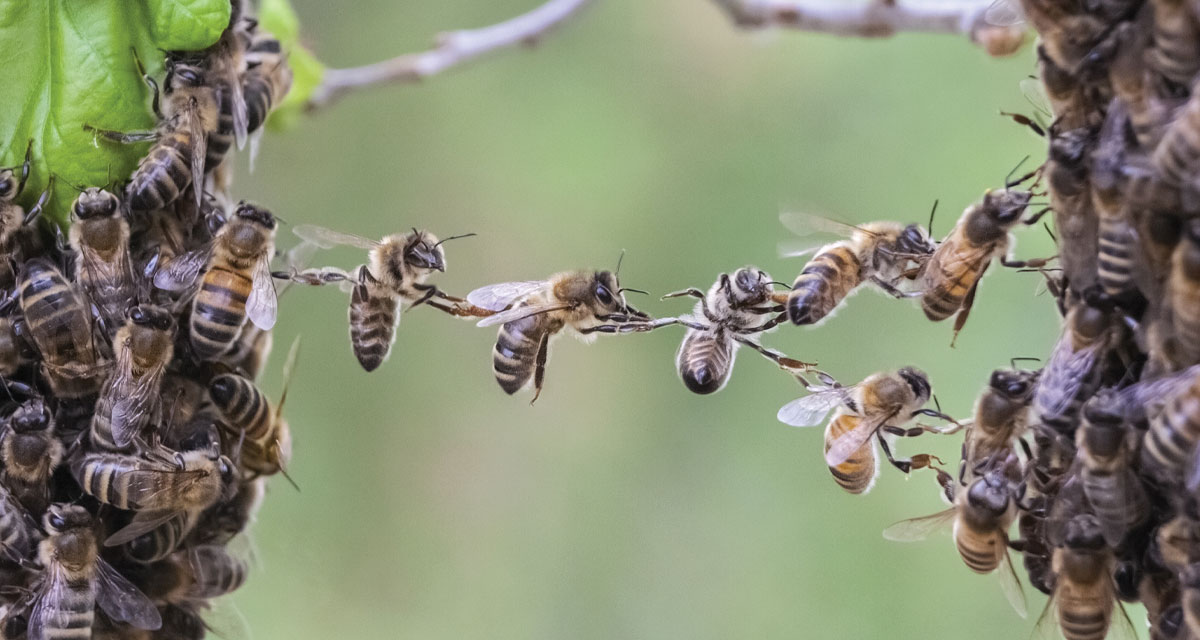Most husbands say things like, “I want to adopt a dog,” not, “I want to raise bees!” The bee idea triggered a childhood memory of performing cartwheels and running to the house after a jarring bite to the palm. From that moment onward, bees, in my mind, were associated with pain, and were an insect well avoided. My husband, Kevin, however, pursued the venture by purchasing a hive, equipment, a beekeeping suit for two, and prepaid for a package of bees and one queen! Immediately, I panicked! How was it arriving? Shock led to the discovery that we would have to pick them up! Together we had watched YouTube videos, attempting to absorb every aspect of the bee world in 30- to 45-minute increments! Then, the fateful day arrived, our bee package was ready for pickup—except Kevin was not in the state! It was up to me! Bravely, I brought home 3,000-plus new charges.
2021 now marks our fourth season as state-certified beekeepers. In the same fashion that people become instantly animated talking about their beloved cat or dog, so I feel about honeybees. Occasionally, a four-winged flyer will land on my hand or shoulder to rest. The sensation feels slightly ticklish from the beat of her wings. In seconds, she disappears, following “orders” to find a water source or pollen.
Honeybees are a network of team discipline, distinct roles, organization, and sacrifice! Each of us can learn a lot from their nature.
- The order of Hymenoptera, to which honeybees belong, appeared 300 million years ago.
- For a queen to develop, she needs royal jelly. Once she emerges from her elongated cell, she flies out to find a drone and receives sperm to sustain her for a lifetime. After 48 hours, she’ll begin laying 2,000 eggs daily. Attendants tend to her feeding needs.
- Bees are trichromatic, which means they see ultraviolet light or wavelengths. Pollen appears as energy, light. They can see three-dimensionally and judge edges.
- The forager bee doesn’t necessarily care about humans. The job is vital, and humans tend to get in the way. At a speed of 20 miles per hour, the honeybee is one of the world’s fastest flyers. Her lifetime contribution is one-twelfth of a teaspoon of honey.
- With an exceptional olfactory ability, honeybees can differentiate between hundreds of floral varieties. Returning to the colony, foragers perform the “waggle dance,” which gives detailed directions and the flight’s distance to the flowers.
- Flying to and from is tiresome. Bees will often sleep inside a flower, sheltered by petals. If a friend is with her, they’ll hold on to each other’s feet.
- Between April to June, hives contain 20,000 to 60,000 female bees. The males, called drones, come and go as they please, are not responsible for chores, and are booted out before winter!
- Worker bees create a glue called “propolis” to seal the edges of their home. Their lifespan extends six weeks.
- At the entrance of every hive is a guard. On cold nights, many will die on duty!
- In a hive are nurse bees, who care for the young, the queen’s attendants, constructor workers who build beeswax foundations, foragers, and undertakers.
- Honeybees judge distances or the length of frames by hanging leg-to-leg in a behavior called “festooning.”
- Bees control their interior temperature by “fanning,” which occurs when bees stand in one direction and fan their wings to add or remove air from the hive. On scorching days, they go outside, hold each other’s legs, and create a “beard.”
- April through June, a colony may grow too large and decide to split. The queen takes 30,000 bees and forms a swarm, flying in counter-clockwise and clockwise circles above the hive. Once the queen lands, protectors will surround her. Foragers will seek a home unless a beekeeper can capture the Queen. If she’s caught, the rest will follow. Meanwhile, back at the hive, the remaining bees await the emergence of their new leader.
- Pesticides result in a “colony collapse disorder.” Does it matter if dandelions are a loathsome weed? It’s the first flower honeybees find in spring to extract nectar from! It either offers food or death!
- Honeybees are one insect that we rely on for pollination. Without them, we would lose plant life and sustainable crops.
North Carolina has the highest number of beekeepers. Look in your neighborhood for stacked hive boxes. And, be thankful! Forager bees support your maple and poplar trees, blueberry bushes, and garden flowers and vegetables. Ask around! You may have a local beekeeper who sells wildflower honey. One taste, and you’ll be an advocate, too!























